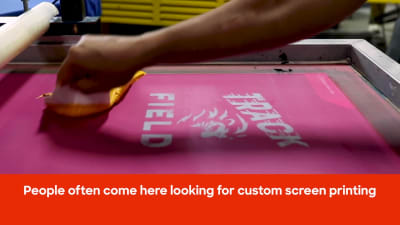Silk Screen Printing for Bold and Lasting Designs
Silk Screen Printing for Bold and Lasting Designs
Blog Article
Display Printing Uncovered: Every Little Thing You Need to Learn About T-Shirt and Garment Printing Methods
Display printing is a fascinating technique that combines art with strategy, providing unlimited opportunities for imagination. All set to discover the important aspects that make display publishing an art kind?
The Fundamentals of Screen Printing: Just How It Functions
When you dive into display printing, you'll find it's both an art and a science. At its core, screen printing entails developing a pattern, or display, that enables ink to pass with just in details areas.
Position the screen over the material, after that make use of a squeegee to push ink with the display onto the garment. Each step is important, and grasping them will certainly raise your display printing abilities, transforming straightforward garments into unique, expressive pieces.
Kinds of Display Printing Methods
When you realize the basics of screen printing, it's time to discover the different methods that can boost your styles. One preferred technique is traditional screen printing, where ink is pushed through a stenciled screen. This strategy is excellent for bold, lively shades. Then there's water-based ink printing, which provides a softer feeling and is green, yet it calls for a various approach to healing.
One more alternative is plastisol printing, recognized for its resilience and vibrant colors, making it a favorite for numerous brands. Experiment with halftone printing to create gradient results and complex layouts.
Important Devices for Display Printing
To attain sensational results in screen printing, having the appropriate tools is fundamental. You'll require a sturdy display printing frame, which holds the mesh that moves your design onto the garment. Next off, invest in top notch mops; these are essential for applying ink uniformly throughout the screen.
Selecting the Right Inks and Materials
When selecting inks and materials for screen printing, you require to consider the kind of ink that works ideal for your project. Think of material compatibility to guarantee your styles look last and fantastic lengthy. Explore eco-friendly ink alternatives to make your printing process a lot more lasting.
Kinds Of Screen Inks
Choosing the ideal screen ink is necessary for accomplishing dynamic, durable prints that satisfy your task's requirements. There are several types of display inks to take a look at. Specialty inks, such as metal or glow-in-the-dark, can include special impacts to your layouts.

Material Compatibility Factors To Consider
Recognizing material compatibility is important for attaining high-grade display prints, especially since different products react uniquely to various inks. When selecting inks, consider the textile type-- cotton, polyester, or blends. For cotton, water-based inks function well, offering softness and breathability. Polyester, on the other hand, often requires plastisol inks for much better attachment and vibrant colors. You might require to use a mix of both types if you're publishing on blends. Always examine your inks on sample textile to guarantee they adhere appropriately and preserve shade honesty. In addition, bear in mind that material weight and appearance can impact the last outcome, so picking the best ink and product combination is essential for your task's success.
Eco-Friendly Ink Options
Eco-friendly inks are coming to be a popular option for screen printers that wish to reduce their ecological influence while maintaining quality. When choosing inks, think about water-based inks, which are less unsafe and simpler to tidy up compared to standard solvents. These inks bond well with materials, providing vibrant results without poisonous chemicals. You could also discover eco-solvent inks that utilize fewer volatile organic compounds (VOCs), making them a much safer alternative for both your wellness and the world.
Additionally, seek inks made from renewable energies, such as soy or vegetable-based options. By selecting the best inks and materials, you'll not just develop magnificent layouts yet additionally contribute to a more sustainable printing process. Make the button, and your prints will certainly mirror your commitment to the environment!
Preparing Your Design for Screen Printing

File Format Needs
To ensure your layout looks dynamic and sharp on fabric, you'll require to pay close attention to file style needs for display printing. Make sure your style has a clear history to stop unwanted white sides on your prints. Maintain shade settings in mind; CMYK is standard for screen printing, so transform your RGB develops appropriately.
Shade Separation Methods
Color splitting up is a crucial action in preparing your design for screen printing, and mastering it can greatly improve your print quality. You'll need to damage your layout right into private shades, as each color needs a separate screen during printing. Begin by determining all the shades in your style and create layers for each one. You can make use click here now of software application like Adobe Photoshop or Illustrator to isolate and separate shades effectively. Be particular to save each layer as a different data, generally in a format like TIFF or PSD. This precision not just guarantees exact color representation yet additionally simplifies the printing procedure. By focusing on shade splitting up, you'll achieve specialist and lively lead to your screen-printed garments.
Resolution and Size
Attaining the finest lead to display printing starts with assuring your design has the appropriate resolution and dimension. Ideally, your artwork should go to least 300 DPI (dots per inch) for sharp, clear prints. Your final item may look less than professional and pixelated. if you make use of reduced resolution.
When it pertains to size, consider the dimensions of your print area. Style your artwork to match the final print size, preferably developing it in the actual measurements you'll be printing. This method, you'll prevent any unexpected scaling concerns.
Constantly inspect your design in both vector and raster formats. Vector graphics can be scaled without shedding quality, making them suitable for display printing. Preparing properly will assure your design looks incredible on every garment!
Step-by-Step Display Printing Process
Display printing is a vibrant procedure that allows you to produce vivid styles on various surface areas. To begin, you'll require a display, solution, and your selected ink. Prepare your screen by cleaning it completely. Next off, use the solution equally and allow it dry in a dark location. When completely dry, subject your display to light with your style positioned on it, which will solidify the solution where the light hits, creating a stencil - screen printing kit.
After rinsing the unexposed solution, your display prepares. Establish it up on your printing surface and align your garment beneath it. Put ink onto the display and utilize a squeegee to push the ink with the stencil onto the fabric. Raise the display very carefully and allow the print completely dry. Finally, treat the ink using warm to guarantee resilience. That's it! You have actually effectively display published your layout.
Tips for Effective Screen Printing Projects
While you're diving into your screen printing projects, keep in mind that prep work is key to success. Start by gathering all your materials-- inks, displays, garments, and mops. A clean work space assists prevent undesirable errors, so clean up before you start.
Following, validate your art work is high-resolution and appropriately sized for your garment. Evaluate your display for proper direct exposure and tidy it completely to stay clear of smudges. When blending your inks, follow the producer's guidelines to attain the appropriate consistency.
Throughout printing, apply also stress with your squeegee for regular results. Do not hurry; take your time to verify each print satisfies your standards. After printing, let your garments dry entirely before managing or packaging them.
Finally, constantly maintain a sample of your benefit future recommendation. In this manner, you can assess your progression and enhance your methods gradually. Delighted printing!

Regularly Asked Concerns
The length of time Does It Require To Establish up a Screen Printing Task?
Establishing a display printing job normally takes around thirty minutes to an hour. You'll prepare the screens, mix inks, and readjust the Learn More Here press. The moment differs based on intricacy and experience, so remain organized!
Can I Print on Different Textile Types Utilizing the Very Same Technique?
Yes, you can publish on various textile kinds utilizing the exact same strategy, but you'll need to adjust your inks and settings. Some materials absorb ink in different ways, so exploring warranties the ideal outcomes for each material.
What Prevail Errors to Avoid in Screen Printing?
When screen printing, stay clear of usual mistakes like utilizing the incorrect ink, neglecting correct exposure times, or skipping pre-press checks. Constantly examine your arrangement and keep tidy screens to guarantee top quality results each time.
Just How Can I Effectively Tidy and Maintain My Screen Printing Equipment?
To properly clean and preserve your screen printing devices, you must regularly wash screens with appropriate solvents, check mops for wear, and assure all tools are saved completely dry and dust-free. Uniformity improves look at this web-site and stops expensive repairs efficiency.
Is Screen Printing Eco-friendly Compared to Various Other Techniques?
Display printing can be more eco friendly than other techniques, especially if you use water-based inks and eco-conscious products. By picking sustainable materials and practices, you reduce waste and reduce your effect on the world.
Display Printing Uncovered: Whatever You Need to Know Concerning Tee and Garment Printing Strategies
At its core, display printing involves creating a stencil, or display, that enables ink to pass with only in details areas. Setting the screen over the material, then make use of a squeegee to push ink through the screen onto the garment. One popular approach is typical screen printing, where ink is pushed with a stenciled screen.When selecting inks and products for display printing, you need to take into account the type of ink that works finest for your job.
Report this page